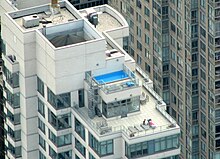Penthouse apartment
This article needs additional citations for verification. (December 2012) |


A penthouse is an apartment or unit on the highest floor of an apartment building, condominium, hotel or tower. Penthouses are typically differentiated from other apartments by luxury features. The term 'penthouse' originally referred, and sometimes still does refer, to a separate smaller 'house' that was constructed on the roof of an apartment building. Architecturally it refers specifically to a structure on the roof of a building that is set back from its outer walls. These structures do not have to occupy the entire roof deck. Recently, luxury high rise apartment buildings have begun to designate multiple units on the entire top residential floor or multiple higher residential floors including the top floor as penthouse apartments, and outfit them to include ultra-luxury fixtures, finishes, and designs which are different from all other residential floors of the building. These penthouse apartments are not typically set back from the building’s outer walls, but are instead flush with the rest of the building and simply differ in size, luxury, and consequently price.
High-rise buildings can also have structures known as mechanical penthouses that enclose machinery or equipment such as the drum mechanisms for an elevator.
Etymology[]
The name penthouse is derived from apentis, an Old French word meaning "attached building" or "appendage". The modern spelling is influenced by a 16th-century folk etymology that combines the Middle French word for "slope" (pente) with the English noun house.[3]
Development[]
European designers and architects long recognized the potential in creating living spaces that could make use of rooftops and such setbacks. Penthouses first appeared in US cities in the 1920s with the exploitation of roof spaces for upscale property. The first recognized development was atop the Plaza Hotel overlooking Central Park in New York City in 1923. Its success caused a rapid development of similar luxury penthouse apartments in most major cities in the United States in the following years.[4]

The popularity of penthouses stemmed from the setbacks allowing for significantly larger private outdoor terrace spaces than traditional cantilevered balconies. Due to the desirability of having outdoor space, buildings began to be designed with setbacks that could accommodate the development of apartments and terraces on their uppermost levels.
Modern penthouses may or may not have terraces. Upper floor space may be divided among several apartments, or a single apartment may occupy an entire floor. Penthouses often have their own private access where access to any roof, terrace, and any adjacent setback is exclusively controlled.
Design[]


Penthouses also differentiate themselves by luxurious amenities such as high-end appliances, finest materials fitting, luxurious flooring system, and more.
Features not found in the majority of apartments in the building may include a private entrance or elevator, or higher/vaulted ceilings. In buildings consisting primarily of single level apartments, penthouse apartments may be distinguished by having two or more levels. They may also have such features as a terrace, fireplace, more floor area, oversized windows, multiple master suites, den/office space, hot-tubs, and more. They might be equipped with luxury kitchens featuring stainless steel appliances, granite counter-tops, breakfast bar/island, and more.
Penthouse residents often have fine views of the city skyline. Access to a penthouse apartment is usually provided by a separate elevator. Residents can also access a number of building services, such as pickup and delivery of everything from dry cleaning to dinner; reservations to restaurants and events made by building staffers; and other concierge services.
For example: the top floor penthouse of Robert A. M. Stern’s 15 Central Park West 20-story apartment building in New York has the following amenities:[5]
- Set on a rooftop terrace, the penthouse has a view of the Midtown Manhattan skyline and at its feet is the whole geometry of Central Park.
- Penthouse ceiling was constructed to be thirteen and a half feet high. Windows were made to be as high and wide as they could be.
- Each section of the penthouse was furnished with unique materials. For the entrance gallery: marble floors and parchment panels framed in mahogany. For the library: Brazilian rosewood. For the dining room: Venetian stucco. For the master bedroom: reefed plaster. For the kitchen: Jaguar-green lacquer, bamboo, and textured glass. For the interiors of the fireplaces: long, narrow 19th-century bricks imported from France.
- This penthouse has a very sophisticated technology system. An anemometer was installed on the roof to measure wind speed so the terraces’ canvas awning can be retracted and does not get ripped off the penthouse’s exalted facade. Moisture sensors were used to detect a leak, automatically sending an e-mail to the building managers. Temperature sensors, strapped to pipes, send an e-mail when the temperature deviates by as little as a single degree from the temperature set by the client.
Cultural references[]
Penthouse apartments are considered to be at the top of their markets, and are generally the most expensive, with expansive views, large living spaces, and top-of-the-line amenities.[6] Accordingly, they are often associated with a luxury lifestyle. Publisher Bob Guccione named his magazine Penthouse, with the trademark phrase "Life on top".[7]
See also[]
- Basement apartment
- Luxury apartment
- Roof garden
 Housing portal
Housing portal
Notes[]
References[]
- ^ Jessica Dailey (July 28, 2015). "Peek Inside the Woolworth Building's $110M Penthouse". Curbed New York. Retrieved March 5, 2016.
- ^ Georgia McCafferty (November 20, 2015). "Asia's most expensive apartment sells for $66 million". CNN Money. Retrieved March 5, 2016.
- ^ Harper, Douglas. "penthouse". Online Etymology Dictionary.
- ^ "Kneen, Orville "Manhattan's $300,000 Rooftop Apartments" Modern Mechanics and Inventions November 1929". Archived from the original on 2012-02-10. Retrieved 2020-05-03.
- ^ Aronson, Steven M. L. "Rooms with a view: inside and out, a New York penthouse attracts attention." Architectural digest. 67.4 (2010): 62-69. Print.
- ^ "WSJ Real Estate". WSJ.
- ^ "Life on Top" USPTO #77653907
External links[]
| Wikimedia Commons has media related to Penthouses. |
- Apartment types
